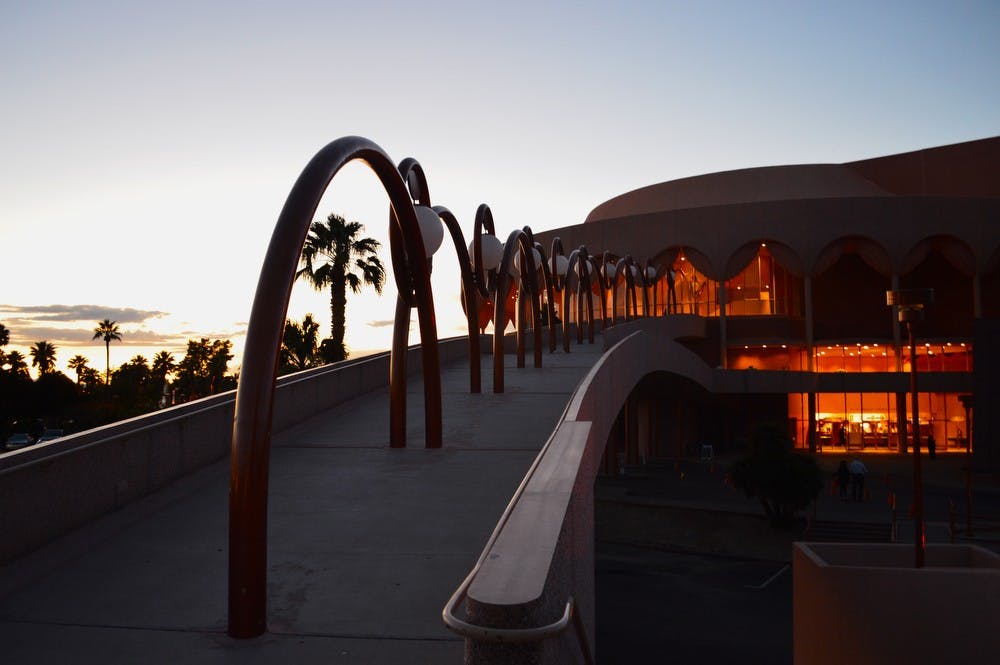Perhaps Tempe’s most historic cultural hub and landmark is Mill Avenue. To students, residents and tourists Mill Avenue may just look like a strip mall littered with bars, restaurants, boutiques and other shops, but a rich history lies in the 1.2 miles between Gammage Auditorium and the Hayden Flour Mill.
In this series, I will be exploring the backstories of Mill from the perspectives of the local business owner, historians and residents. By the end of this series, my goal is to create a timeline of Tempe’s hottest spots and their humble, historical origins.
The Grady Gammage Memorial Auditorium, also referred to as ASU Gammage or The Gammage Auditorium, may be ASU and Arizona’s most cherished landmark, standing on the southwest corner of the Tempe campus with its inviting, sprawling staircase welcoming all ASU visitors from around the world.
Read More: ASU celebrates 50 years of cultural excellence, community involvement at Gammage Auditorium
Gammage has been a staple in the Valley’s architectural personality for over 50 years since its grand opening on Sept. 18, 1964 when Eugene Ormandy conducted the world-famous Philadelphia Orchestra to indicate the birth of one the U.S.' greatest performance halls.
Pre-1958
But 1200 S. Forest Ave hasn’t always been home to the Gammage. In fact, before the ‘60s it was a women’s athletic field. Tempe resident and historian Larry Mischler remarked about the important history of the lot pre-Gammage.
“After World War II, up until about 1960, they put in Quonset huts,” Mischler said. “They were long huts and they used them as barracks. They had a bunch of those (at Gammage) and they used them as GI housing for GI students. Then in the ‘60s the GI Bill ran out and things got different so they didn’t need the housing. That's when they built the auditorium.”
However, master architect Frank Lloyd Wright, known for buildings ranging from Fallingwater to the Guggenheim Museum, didn’t intend for the Gammage blueprints to ever be brought to life in Arizona. Initially, Wright designed the current model as an opera house for Baghdad, Iraq. Two worlds collided on July 14, 1958, when King Faisal II of Iraq was assassinated along with his family during the 14 July Revolution. After King Faisal II’s death, all communications and plans for an opera house designed by Wright ceased.
In the late ‘50s, ASU President Grady Gammage approached Wright, a good friend, and asked if he would be interested in designing an auditorium for ASU. Eventually, Wright decided that the design originally to be used for the opera house in Baghdad would be a great statement for ASU.
1958-1964
Frank Lloyd Wright adjusted his plans to better serve the Arizona community throughout his last few years up until his death in 1959. After Wright died, his protégé William Wesley Peters took over and finished the designing. In the winter of 1959, while still in office, Grady Gammage also died.
In 1962, the R.E. McKee Company took over the construction and Grady Gammage Jr. became the first person to shovel Gammage dirt at its official groundbreaking.
Many of Wright’s critics attack Wright’s later work for the grandiose exterior, but most complain about bland interior rooms. Despite the detractions, Gammage is a huge technical feat and uses space impressively.
With over 3,000 seats, Gammage is one of America’s most accommodating performance spaces, and the furthest seat in the auditorium is only 115 feet away from the stage which creates an intimacy in spite of Gammage’s vastness.
Gammage is also a very versatile and adaptable performance space which expertly accommodates musical theater, symphonic and organ performances and even smaller chamber ensembles.
Musical theater is what brings most ASU students and Arizonians to Gammage. The Broadway production “Camelot” was the first to play at Gammage in its premiere season in 1964. Since then, productions of some of Broadway’s most popular hits like “The Lion King,” “The Phantom of the Opera,” “Les Miserables” and “Miss Saigon” have performed on the Gammage stage. Currently, the touring cast of "The Book of Mormon" graces Gammage's stage.
1964-onwards
Since its creation, Gammage has had five executive directors. Gammage has been led by executive director Colleen Jennings-Roggensack since 1991, who plays a vital role in maintaining Gammage as a performance hall, a relevant Tempe landmark and a community tool.
“Gammage has become a great laboratory of learning,” Jennings-Roggensack said. “Many of our classes, our larger ensembles at the School of Music perform here. The Origins Project kicked off with Stephen Hawkings at Gammage.”
Jennings-Roggensack and the past executive directors of Gammage have brought infinite opportunities to the musicians and children of the Valley. It hosts many functions and programs to support 134,000 Arizonian kids who attend schools that don’t have access to to fine arts.
Jennings-Roggensack also brought a new initiative to Gammage called "Connecting Communities" which focuses on reaching out beyond the auditorium and enriching the lives of the residents of Tempe and its neighboring communities through music.
The ASU School of Music students and bands all greatly appreciate the historical and technical accomplishment that is ASU Gammage. Gary Hill, ASU Director of Bands, feels especially enamored and appreciative of what Gammage brings to ASU.
“Gammage Auditorium is one of the true jewels of ASU’s beautiful campus,” Hill said. “Having many opportunities each year to perform in such a stunning facility is a privilege both faculty and students at the School of Music treasure.”
Related links:
An abridged history of Mill Avenue: A secret cultural hub of Tempe
An abridged history of Mill Avenue: The hauntings of Casa Loma Building
Reach the reporter at tanner.stechnij@asu.edu or follow @tannerstechnij on Twitter.
Like The State Press on Facebook and follow @statepress on Twitter.




